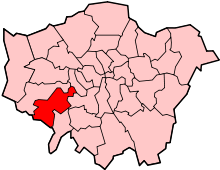Royal Botanic Gardens, Kew
 | |
| Type | Non-departmental public body |
|---|---|
| Location | |
Key people |
|
Budget | £65.6 million[1] |
Employees | 723 (FTE)[1] |
| Website |
www |
Royal Botanic Gardens, Kew (brand name Kew) is a non-departmental public body in the United Kingdom sponsored by the Department for Environment, Food and Rural Affairs. An internationally important botanical research and education institution, it employs 723 staff (FTE).[1] Its board of trustees is chaired by Marcus Agius,[1] a former chairman of Barclays.
The organisation manages botanic gardens at Kew in Richmond upon Thames in southwest London, and at Wakehurst Place, a National Trust property in Sussex which is home to the internationally important Millennium Seed Bank, whose scientists work with partner organisations in more than 95 countries.[2] Kew, jointly with the Forestry Commission, founded Bedgebury National Pinetum in Kent in 1923, specialising in growing conifers.[3] In 1994 the Castle Howard Arboretum Trust, which runs the Yorkshire Arboretum, was formed as a partnership between Kew and the Castle Howard Estate.[4]
The organisation had 2,124,138 public visitors in the year 2016/17.[1] Its 326-acre (132 ha) site at Kew has 40 historically important buildings; it became a UNESCO World Heritage Site on 3 July 2003.[5] The collections at Kew and Wakehurst Place include over 28,000 taxa of living plants, 8.3 million plant and fungal herbarium specimens, and 30,000 species in the seed bank.[1]
Governance
Kew is governed by a board of trustees which comprises a chairman and eleven members. Ten members and the chairman are appointed by the Secretary of State for Environment, Food and Rural Affairs. Her Majesty the Queen appoints her own trustee on the recommendation of the Secretary of State. As of 2018 the Board members are:[6]
- Marcus Agius (Chairman)
- Sir Henry Keswick (appointed by HM The Queen)
- Nick Baird
- Professor Liam Dolan
- Catherine Dugmore
- Sarah Flannigan
- Valerie Gooding
- Professor Sue Hartley
- Ian Karet
- Jantiene Klein Roseboom van der Veer
- Michael Lear
- Sir Derek Myers
- Professor Malcolm Press
Scientific staff
The Director of Science is University of Oxford Professor Kathy Willis. Her deputy is Professor Monique Simmonds. Professor Mark Chase is Senior Research Professor.[7]
Resources at Kew
International Plant Names Index
The Harvard University Herbaria and the Australian National Herbarium co-operate with Kew in the IPNI (International Plant Names Index) database, a project which was launched in 1999 to produce an authoritative source of information on botanical nomenclature including publication details. The IPNI includes information from the Index Kewensis, a project which began in the 19th century to provide an "Index to the Names and Authorities of all known flowering plants and their countries".[8]
The Plant List
Kew also cooperates with the Missouri Botanical Garden in a related project called The Plant List; unlike the IPNI, it provides information on which names are currently accepted. The Plant List is an Internet encyclopedia project which was launched in 2010 to compile a comprehensive list of botanical nomenclature.[9] The Plant List has 1,040,426 scientific plant names of species rank of which 298,900 are accepted species names. In addition, the list has 620 plant families and 16,167 plant genera.[10]
See also
- Royal Botanic Gardens, Kew's two main sites:
- Botanists active at Kew Gardens
- Curtis's Botanical Magazine, an illustrated publication which began in 1787 and is published by Wiley-Blackwell for the Royal Botanic Gardens, Kew
- Directors of the Royal Botanic Gardens, Kew
- GrassBase
- Index Kewensis, a massive index of plant names started and maintained by Kew Gardens
- Joseph Dalton Hooker, who succeeded his father, William Jackson Hooker, as director in 1865
- Kew Bulletin, a peer-reviewed scientific journal published by Springer Science+Business Media on behalf of the Royal Botanic Gardens, Kew
- The Great Plant Hunt, a primary school science initiative created by Kew Gardens, commissioned and funded by the Wellcome Trust
References
- 1 2 3 4 5 6 "Annual report and accounts 2016–17" (PDF). Royal Botanic Gardens, Kew. 10 July 2017. Retrieved 26 August 2017.
- ↑ "How we work". Millennium Seed Bank. Royal Botanic Gardens, Kew. Retrieved 26 August 2017.
- ↑ England, Forestry Commission,. "History of Bedgebury National Pinetum". www.forestry.gov.uk. Retrieved 2018-08-15.
- ↑ "Background". Yorkshire Arboretum. Retrieved 2018-08-15.
- ↑ Guinness World Records 2011. Guinness World Records. 2010. p. 69. ISBN 978 1 904994 57 2.
- ↑ "Board of Trustees". Royal Botanic Gardens, Kew. 20 January 2018.
- ↑ "People". London: Royal Botanic Gardens, Kew. Retrieved 26 August 2017.
- ↑ Hooker, Joseph Dalton, 1893 Preface. In Index Kewensis: an enumeration of the genera and species of flowering plants from the time of Linnaeus to the year 1885 inclusive (ed. B D Jackson). Oxford: Clarendon
- ↑ Bates, Claire (5 January 2011). "Botanical A–Z via Kew: British experts complete database of every plant name on the planet – all 1.25million of them". Daily Mail. London. Retrieved 19 May 2015.
- ↑ Satter, Raphael G. (29 December 2010). "US, British scientists draw up comprehensive list of world's known land plants". boston.com. Retrieved 15 September 2014.
External links
| Wikimedia Commons has media related to Royal Botanic Gardens, Kew. |
